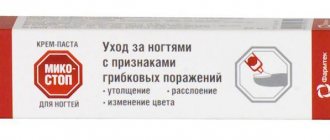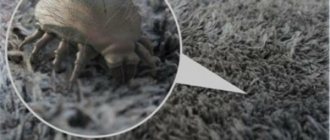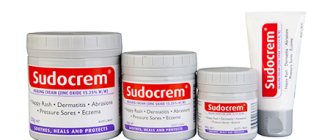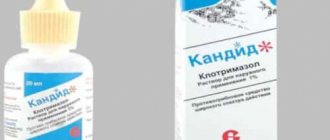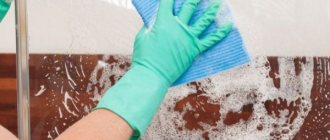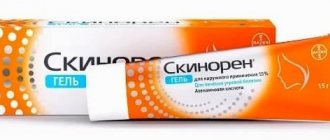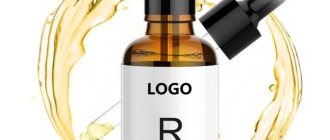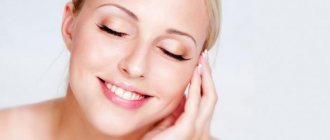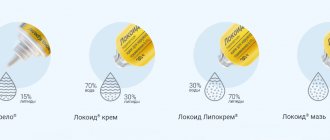The article provides information on what Levomekol ointment is used for and what it consists of. You will also learn how to use the drug when it is contraindicated.
When there are wounds, abrasions, pimples, and inflammation on the skin, many patients think that it is better to use expensive imported products for treatment. But it is not always the case. There is no need to buy the most expensive drugs from pharmacies to cure these pathologies. It is enough to take Levomekol ointment and apply it correctly. With its help you can heal wounds from burns, ulcers, boils, hemorrhoids, sinusitis, and other skin ailments and other inflammations.
Properties and composition of the ointment
The medicine contains two main active ingredients - chloramphenicol (chloramphenicol) and methyluracil (dioxomethyltetrahydropyrimidine).
Chloramphenicol is a powerful broad-spectrum antibiotic that is highly effective against many bacteria that live on the skin of the face. It is able to penetrate deeply into tissues, without damaging the cell membrane and stimulating the healing of lesions affected by the inflammatory process. The antibiotic also helps draw out existing pus.
Methyluracil is a medicinal element that improves tissue trophism and stimulates the wound healing process. The active substance starts the process of growth and reproduction of healthy epidermal cells and increases its resistance to microbes and bacteria. Additionally, the component helps to calm down the inflammatory process by improving local blood circulation and enriching skin cells with oxygen.
Chloramphenicol enhances the medicinal effect of methylarucil, which makes Levomekol for acne one of the most effective topical medications.
The principle of action on rashes
Levomekol acne ointment, thanks to its main active ingredients, has the following therapeutic effect on inflamed areas of the skin:
- kills bacteria and prevents their further reproduction;
- eliminates redness and swelling;
- relieves pain;
- draws out purulent contents;
- accelerates the process of restoration of damaged tissues.
Since methyluracil promotes the development of local immunity, it can additionally prevent the appearance of new rashes.
Prevention of the problem
In addition, there are ways to help avoid the appearance of corns or open wounds of this type on the skin altogether. And these are:
- Wearing shoes in your size. Therefore, you should not choose too tight or narrow shoes that put pressure on your toes and rub. Rough material of the product or high heels can also have a negative effect;
- Wearing socks that reduce shoe contact area and friction. For high physical activity, thick socks that absorb moisture well and are made of polyester with wool are ideal;
- Use an antiperspirant on your feet to reduce moisture and reduce mechanical stress;
- Constant foot hygiene;
- The required amount of rest, which must be combined with the fact that you will still take off your socks to air your feet;
- Using gel pads, gloves and knee pads that will protect skin areas from friction;
A miracle remedy for combating calluses on the skin
If you take this problem seriously and carry out the necessary prevention, then you may not encounter the appearance of calluses on the skin at all. And you will not need the help of Levomekol medication and sterile dressings. Remember that your feet are subject to the greatest stress, so they need to be protected and taken care of.
For what types of acne is it used?
Levomekol ointment for acne on the face is recommended for use for purulent and internal painful rashes, which are characteristic of the following forms of acne:
- papulopustular;
- fulminant;
- cystic.
Severe forms of acne require local and sometimes internal use of antibiotics. One of these is chloramphenicol, which is most often prescribed for external use in the form of an ointment.
Timely use of the product helps get rid of acne spots, or rather, prevents their occurrence. Thus, the antibiotic does not get rid of acne spots, but only prevents their appearance.
Where do calluses most often appear?
For calluses, Levomekol ointment can help at almost any stage, but initially it is worth deciding where they most often appear:
- The sole, because it is this part of the body that is subject to the greatest number of active actions;
- The areas of skin between the toes are exposed to tight shoes or suffer from foot deformities;
- Palms are also susceptible to calluses due to a profession involving heavy mechanical labor when using various tools;
- Knees suffer if you stand on them for a long time;
- Elbows;
- The area of the limb remaining after amputation becomes harder and rougher, as a result of which seals appear;
If the problem occurred precisely in these areas of the skin, it was precisely because it was already roughened and did not allow acute damage to occur.
Another reason can be attributed to the fact that frequent friction or professional activity over a long period of time causes the skin to act and divide cells with greater frequency.
How to use ointment for acne
Before using Levomekol for acne, you should first wash your face using specialized gels. After this, the affected areas of the dermis are wiped with an antiseptic. This may be hydrogen peroxide, Miramistin or Chlorhexidine.
After the skin has dried, apply antibacterial ointment to the sites of localization of the inflammatory or purulent process. The product is not washed off. It is necessary to apply antibiotic to acne in the morning and evening.
Globular acne requires the use of a medicated bandage. The drug is applied to a sterile gauze pad and applied to the sore spot for a day, having previously treated the surface with an antiseptic.
It is not recommended to use the ointment for more than 7-10 days to avoid side effects.
Additional Information
Before using the ointment, you must make sure that there is no allergic reaction to this product. To do this, you need to apply the consistency to the bend of the elbow joint or wrist. If there are no signs of allergy, the ointment is approved for use. The drug should be applied with caution at the border between the mucous membrane and the skin.
Since the drug is not a hormonal drug, it is safe for children, but before use it is necessary to consult a pediatrician. Levomekol is recommended for women in the treatment of damaged nipples during breastfeeding. Before feeding, after applying the ointment, the breasts should be thoroughly rinsed with water.
Does not affect the ability to drive a vehicle or operate machinery.
Store in a cool, dark place, away from direct sunlight at a temperature not exceeding 20 degrees. Keep away from children. Available in pharmacies without a doctor's prescription. Shelf life: 3 years and 6 months. from the date of manufacture. Do not use after expiration date. In case of contact with eyes, rinse with plenty of water.
The average cost of Levomekol ointment with a volume of 40 g ranges from 115 to 125 rubles. The price varies depending on the manufacturer, region of residence, and pharmacy chain.
In what cases is the drug contraindicated?
Levomekol against acne is not used in cases of dermatological diseases such as demodicosis complicated by fungal infection, eczema, psoriasis, skin candidiasis, etc.
The product should not be used if individual intolerance to the constituent components develops.
Pregnant and lactating women are also prohibited from using the medicine, since the antibiotic has the ability to penetrate into the blood and milk.
What to do to avoid complications?
If you do not adhere to the basic rules of treatment, complications may arise, because bacteria that enter the body through the wound can then follow into the fatty tissue, and then into the general bloodstream. Thus, the spread of infection and pathogenic microorganisms throughout the human body begins. To prevent this from happening, you must:
- Pierce the wound only with a disinfected needle;
- Maintain coating density;
- Protect skin from friction or damage;
- Carry out frequent dressing changes only with sterile elements;
- Do not allow moisture or sweat to get under the bandage;
Does Levomekol help with acne: as evidenced by reviews from dermatologists
Dermatologists confirm that Levomekol ointment helps against acne. However, doctors also warn about serious adverse reactions that can occur over long-term use. If an antibacterial agent is used for more than 10 days in a row, then there is a high probability of bacteria developing resistance to the drug. In this case, further therapy will be ineffective.
Also, prolonged and irrational use causes the development of hypersensitivity to the constituent components, which in turn can lead to serious allergic reactions.
To ensure that the medicine does not become addictive, reviews from dermatologists recommend alternating it with other anti-acne medications that do not contain the antibiotic chloramphenicol.
Most doctors advise using safer and more modern treatments for acne. Such drugs as Differin, Baziron AS and others have proven themselves well. They rarely lead to adverse reactions and show good results after just a few days of regular use.
Indications for use
The action of Levomekol can be aimed at both treatment and prevention of certain ailments. Most often, this medicine is recommended by doctors for the following conditions:
- purulent infected wounds;
- swelling;
- trophic ulcers;
- pronounced inflammation;
- second and third degree burns;
- purulent pathologies, such as boils;
- damage that requires cleaning from dead particles and pus;
- some diseases of the epidermis;
- dental problems;
- haemorrhoids.
As a preventive measure, the product is applied to wet calluses, bedsores, eczema, fresh stitches, and cuts. In addition, Levomekol contains an antibiotic that is incredibly effective against hemorrhoids, sinusitis, acne, otitis media, and balanoposthitis. In gynecology, tampons with ointment are often used to treat inflammation of the appendages, cervical erosion and healing of sutures in the vagina. The duration of therapy is selected individually, depending on the severity of the pathology and the characteristics of the body.
Among other things, in the reviews you can find a lot of useful information about how else it is permissible to use this product. Is it possible to use Levomekol after hair removal? According to users, this ointment allows you to get rid of small pustules that appear after this procedure. And some reviews contain information that it is “Levomekol” that helps eliminate itching and burning after insect bites.
As you can see, the scope of application of the ointment is very wide. But despite the positive reputation of the drug, one should not forget that this remedy is potent. Each person decides for himself whether to use ointment or not. Levomekol is an antibiotic, and its too frequent use can lead to unpleasant consequences. Don't forget about this.
Real user reviews
Kate:
I squeezed out a purulent pimple, after which the area began to hurt a lot. I applied a bandage with Levomekol at night. In the morning, the product pulled out the remaining pus. I applied it for a couple more nights, after which the wound began to heal.
Olga:
Previously, cold acne popped up all the time. She was saved only by Levomekol. The drug helped, but after a while the rashes appeared again. I contacted a dermatologist. He prescribed me a course of antibiotics and immunostimulants. After this, the acne became significantly smaller and the need for using an antibiotic disappeared on its own.
Analogues of Levomekol - which ones are there and what to choose?
Levomekol for acne can be replaced with drugs with a similar composition, which include:
- Levomycetin ointment;
- Syntomycin ointment.
Levomycetin ointment contains only one active substance - chloramphenicol. The instructions recommend using the product in the complex treatment of boils. The drug also treats large acne. It is applied directly to acne 1 or 2 times a day.
In addition to chloramphenicol, syntomycin liniment contains castor oil, which has a similar effect on the skin as methyluracil. Additionally, the component of plant origin has a keratolytic effect. To treat subcutaneous acne, the product should be applied according to the scheme described above.
Before using any antibacterial drug, it is recommended to consult a dermatologist to avoid complications.
